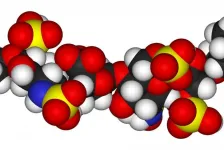Research pinpoints unique drug target in antibiotic resistant bacteria
2021-03-08
(Press-News.org) Researchers have identified a critical mechanism that allows deadly bacteria to gain resistance to antibiotics.
The findings offer a potential new drug target in the search for effective new antibiotics as we face the growing threat of antimicrobial resistance (AMR) and infections caused by bacterial pathogens.
The study investigated quinolone antibiotics which are used to treat a range of bacterial infections, including TB (tuberculosis). Quinolones work by inhibiting bacterial enzymes, gyrase and topoisomerase IV, thereby preventing DNA replication and RNA synthesis essential to growth.
They are highly-successful antimicrobial agents widely used in current medicine, however bacterial resistance to them and other treatments is a serious problem.
Previous studies had identified one resistance mechanism caused by the production of pentapeptide repeat proteins (PRPs), a family of molecules that also act as DNA gyrase inhibitors.
One of these, called MfpA, confers quinolone resistance to Mycobacterium tuberculosis, the causative agent of TB.
In this study John Innes Centre researchers in the group of Professor Tony Maxwell set out to discover how PRPs such as MfpA, work at the molecular level.
They purified MfpA from Mycobacterium smegmatis, a close relative of M. tuberculosis, and showed that it can inhibit the supercoiling reaction of DNA gyrase, the target of quinolones in TB causing mycobacteria.
Further investigations showed that MfpA can prevent poisoning of gyrase by quinolones, thus protecting the bacterial host cell from the antibiotic.
Using X-ray crystallography, the researchers showed that MfpA binds to the ATPase domain of gyrase, and that this explains its ability to both inhibit the supercoiling reaction and prevent quinolone poisoning.
"We did not expect the exact mechanism of MfpA to be the prevention of DNA binding to the gyrase ATPase domain; this is a unique mode of action," said Professor Tony Maxwell, corresponding author of the study.
"We believe this understanding will help drive new ideas for antibiotic development among academics and researchers in the pharma industry," he added.
Further investigative work will involve molecular modelling based on the MfpA-gyrase structure to design small molecules that could mimic this interaction and offer more insights into how it works.
INFORMATION:
The study: Pentapeptide-repeat protein, MfpA, interacts with mycobacterial DNA gyrase as a DNA T-segment mimic appears in PNAS.
Funding for the research was provided by BBSRC, Wellcome Trust, Centre of Excellence for Plant and Microbial Science (CEPAMS), Ministry of Science and Technology of China, National Natural Science Foundation of China, International Joint Research Project of the Institute of Medical Science, University of Tokyo.
Fluoroquinolones and quinolones are broad-spectrum antibiotics that are active against a wide range of bacteria of both Gram-negative and Gram-positive classes.
A recent review by Professor Maxwell's group highlights the mechanisms of action of fluoroquinolones and discusses the potential pathways leading to cell death. The research also considers quinolone resistance and how quinolone treatment can lead to resistance to non-quinolone antibiotics.
https://www.mdpi.com/1420-3049/25/23/5662
[Attachments] See images for this press release:

ELSE PRESS RELEASES FROM THIS DATE:
2021-03-08
Spectacular fossil plants preserved within a volcanic ash fall in China have shed light on an evolutionary race 300 million years ago, which was eventually won by the seed-bearing plants that dominate so much of the Earth today.
New research into fossils found at the 'Pompeii of prehistoric plants', in Wuda, Inner Mongolia, reveals that the plants, called Noeggerathiales, were highly-evolved members of the lineage from which came seed plants.
Noeggerathiales were important peat-forming plants that lived around 325 to 251 million years ago. Understanding their relationships to other plant groups ...
2021-03-08
TROY, N.Y. -- Using a nanopore, researchers have demonstrated the potential to reduce the time required for sequencing a glycosaminoglycan -- a class of long chain-linked sugar molecules as important to our biology as DNA -- from years to minutes.
As published this week in the Proceedings of the National Academies of Sciences, a team from Rensselaer Polytechnic Institute showed that machine-learning and image recognition software could be used to quickly and accurately identify sugar chains -- specifically, four synthetic heparan sulfates -- based on the electrical signals generated as they passed through a tiny hole in a crystal wafer.
"Glycosaminoglycans are a complex repertoire of sequences, ...
2021-03-08
An international team of scientists have explained how legume trees are key in liberating minerals locked in iron minerals and the benefits are passed on to nearby trees
The research shows that the trees are able to alter their soils microbiome in a way that increases access to nutrients and supports growth
The findings provide new insight into the role of these trees in safeguarding the function of tropical forests and sustainable reforestation
Researchers have found that nitrogen-fixing legume trees can support themselves and surrounding trees not only with increased access to nitrogen, but with other key nutrients through enhanced mineral weathering.
The team, led by the University ...
2021-03-08
In the United States, one in 10 babies are born too soon, resulting in complications that can affect their locomotor development and influence such simple tasks as balance, walking and standing later in life. A new peer-reviewed study by Children's National Hospital, published in the Proceedings of the National Academy of Sciences of the United States of America (PNAS), explores exactly what neural circuitry of the cerebellum is affected due to complications that occur around the time of birth causing these learning deficits, and finds a specific type of neurons -- Purkinje cells -- to play a central role.
Up until now, there has been a sparsity of techniques available to measure neuronal ...
2021-03-08
American adults without a college degree have experienced greater reductions in life expectancy when compared to their more-educated counterparts, USC and Princeton researchers have found.
The study reveals that after nearly a century of declining mortality up to the late 1990s, the progress continued into the 21st century for more-educated Americans but stalled for the population as a whole and reversed for the two-thirds of Americans who do not have a college degree.
The study appeared Monday in the Proceedings of the National Academy of Sciences.
The ...
2021-03-08
Malaria is the deadliest pathogen in human history. Nearly half the people on Earth are at risk of contracting the disease from the parasites that cause it. But humans aren't the only ones who can get these parasites--different forms are found in other animals, including birds. By studying the DNA of those strains, scientists can get a better picture of how malarial parasites live, which may give clues on how to stop the disease. In a new paper in PNAS, researchers analyzed blood samples of more than 1,000 species of birds from the Andes looking for malaria; they found that the strains of malaria present in a local area don't always neatly align with the types of birds living there.
"Traditionally, we thought that there's ...
2021-03-08
(Boston)--Despite the positive advances that anti-human immunodeficiency virus (HIV) therapy, commonly called anti-retroviral therapy (ART) or highly active antiretroviral therapy (HAART), has had on the life expectancy of HIV-positive people, finding a cure for HIV or acquired immunodeficiency syndrome (AIDS) has remained elusive.
"One of the major challenges in curing HIV is that there is a persistent latent reservoir of virus that is not targeted by current antiretroviral treatments and is hidden from immune cells. When treatment is interrupted, this reservoir of the virus allows the HIV ...
2021-03-08
Here is a link to a free Altmetric Report on this Research Output
Aging-US published "Hyperbaric oxygen therapy increases telomere length and decreases immunosenescence in isolated blood cells: a prospective trial" which reported that the aim of the current study was to evaluate whether hyperbaric oxygen therapy (HBOT) affects telomere length (TL) and senescent cell concentrations in a normal, non-pathological, aging adult population.
Thirty-five healthy independently living adults, aged 64 and older, were enrolled to receive 60 daily HBOT exposures.
Whole blood samples were collected at baseline, at the 30th and 60th session, and 1-2 weeks following the last HBOT session.
Telomeres length of T helper, T cytotoxic, natural killer and ...
2021-03-08
CHAMPAIGN, Ill. -- Tiny fluorescent semiconductor dots, called quantum dots, are useful in a variety of health and electronic technologies but are made of toxic, expensive metals. Nontoxic and economic carbon-based dots are easy to produce, but they emit less light. A new study that uses ultrafast nanometric imaging found good and bad emitters among populations of carbon dots. This observation suggests that by selecting only super-emitters, carbon nanodots can be purified to replace toxic metal quantum dots in many applications, the researchers said.
The findings, published in the Proceedings of the National Academy of Sciences, ...
2021-03-08
About one billion people worldwide are at risk for schistosomiasis -- a debilitating disease caused by parasitic worms that live in fresh water and in intermediate snail hosts. A new study finds that the transmission risk for schistosomiasis peaks when water warms to 21.7 degrees centigrade, and that the most effective interventions should include snail removal measures implemented when the temperature is below that risk threshold.
The Proceedings of the National Academy of Sciences published the results, led by Emory University, the University of South Florida and the ...
LAST 30 PRESS RELEASES:
[Press-News.org] Research pinpoints unique drug target in antibiotic resistant bacteria





